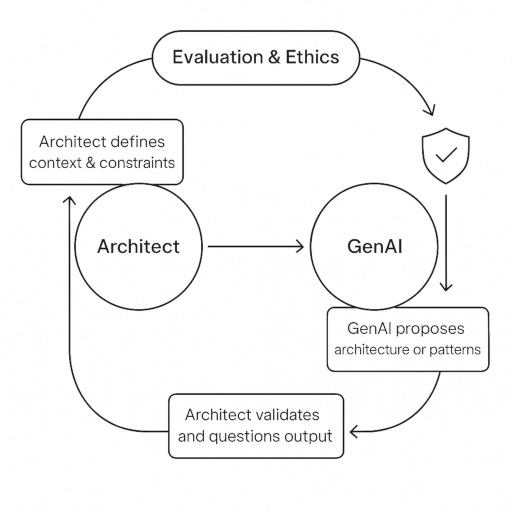GenAI for Architects: Designing with Confidence, Guardrails, and Ethics
AI Security & Development
GenAI is no longer a “nice to have” in architecture work. The question isn’t if it can help, but how much we should trust it.
Architects now use AI to draft patterns, compare trade-offs, and even produce diagrams. Done well, it speeds up the journey from idea to system. Done poorly, it can hide risks in the foundations of our designs.
From Helper to Collaborator
We’ve moved past treating GenAI as just another tool. Many architects now lean on it for solution ideas, alternative designs, and justification for decisions. Prompt and context engineering have become a kind of rapid, flexible architectural sketching.
But that collaboration comes with responsibility. GenAI can suggest polished, plausible architectures that are wrong, insecure, or misaligned with reality. It’s no longer echoing code samples, it’s proposing service stacks, state models, and security policies.
The architect’s role now includes validating, questioning, and guiding AI-generated outputs.
The Risk of Architectural Hallucination
LLMs hallucinate, and in architecture, those mistakes are costly.
Common failure modes:
Overconfident inaccuracies – Referencing deprecated services, misusing IAM policies, or inventing features.
Security anti-patterns – Recommending public S3 buckets, no encryption, or weak validation.
Misaligned NFRs – Optimizing for speed or simplicity while ignoring cost, observability, or compliance.
Context mismatch – Defaulting to “popular” stacks even when they don’t fit the business or team skills.
These aren’t small bugs, they’re systemic risks that can silently shape the entire system.
Validation Patterns for AI-Generated Architecture
To use GenAI responsibly, build in repeatable checks:
Chain-of-thought prompting – Have the AI reason step-by-step before giving a design.
Ensemble prompting – Compare solutions from multiple models; differences reveal hidden assumptions.
Prompt-context traceability – Track what you asked and the context provided for audits or reviews.
Critique agents – Use a second model or prompt to review the first output for risks and omissions.
Structured like this, the process feels like an architectural peer review.
Ethical Dimensions in AI-Augmented Design
Architecture always involves ethics, privacy, cost, accessibility, sustainability.
GenAI adds more:
Design bias – Are we unintentionally excluding certain users?
Environmental cost – Are we choosing energy-efficient architectures?
Accessibility and inclusion – Are diverse user needs considered?
Good architecture isn’t just valid, it’s fair, inclusive, and forward-looking.
The Architect AI Design Responsibility Loop
A simple model:
Define context and constraints – Set requirements, risks, and boundaries.
GenAI proposes – The AI produces patterns or architectures.
Validate and question – Critique outputs, run multi-agent checks.
Revise with feedback – AI updates designs based on new constraints.
All of this sits inside a larger sphere: Evaluation and Ethics. That’s the safeguard.
Playbook: Architecting With AI, Responsibly
🗂 Prompting
State business context and goals clearly.
Define NFRs early.
Use structured, multi-step prompts.
🔎 Evaluation
Cross-check outputs from different tools.
Ask for the reasoning behind each decision.
Combine manual and automated reviews.
📋 Documentation
Keep input/output pairs for traceability.
Annotate decisions with “why.”
Capture feedback cycles.
🎯 Ethics
Consider who benefits and who’s excluded.
Weigh cost, sustainability, and usability.
Challenge “default” solutions.
A one-page Architecture Ethics Canvas can make these considerations explicit.
Closing Thoughts
GenAI doesn’t replace architects, it expands what we can do. But with that expansion comes the duty to validate, interpret, and act as ethical stewards.
In this frontier, success isn’t about trusting AI. It’s about knowing how to question it, and when to draw the line.
Want the full deep dive? Check out my full article on Medium.
🚀 Stay tuned for more posts in AI Security & Development! Follow for more insights on securing AI, cloud, and Web3.
AI Security & Development - AI table of contents included.
GenAI for Architects: Designing with Confidence, Guardrails, and Ethics



